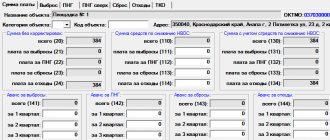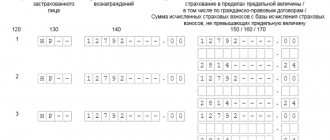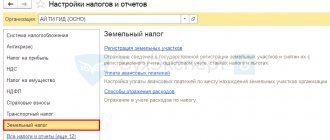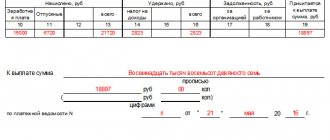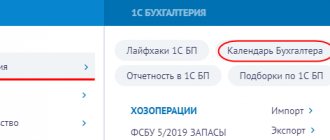Who is the payer of the tax collection fee?
Payers of the fee for negative environmental impact (NEI) are organizations and individual entrepreneurs that emit pollutants into the air through stationary sources, into water bodies or are engaged in the storage and burial (disposal) of waste (clause 1 of article 16, clause 1 Article 16.1 of the Law “On Environmental Protection” dated January 10, 2002 No. 7-FZ).
Decree of the Government of the Russian Federation dated September 18, 2020 No. 1496 contains a complete list of types of activities and other criteria for classifying objects into categories I–IV of environmental impact, in which the organization must pay for the environmental impact assessment. In particular, these include mining, metallurgical, chemical, food production, some agricultural companies, and municipal solid waste landfills.
If business activities are carried out only at category IV facilities, then there is no need to pay a fee for negative impact (Clause 1, Article 16.1 of Law No. 7-FZ).
Category IV includes facilities where:
- there are no releases of radioactive substances;
- there are no discharges of pollutants generated when water is used for industrial needs into sewers and the environment, surface and underground water bodies, as well as onto the earth's surface;
- there are discharges of pollutants resulting from the use of water for domestic needs;
- there are stationary sources of pollutant emissions, and their quantity is no more than 10 tons per year;
- There are only non-stationary sources of pollutant emissions.
Thus, the use of motor transport in business activities does not lead to the need to pay for negative impacts, since payment is made only for stationary objects, to which it (motor transport) does not apply (Clause 1, Article 16 of Law No. 7-FZ).
IMPORTANT! The obligation to pay the fee does not depend on the tax regime applied by organizations or individual entrepreneurs that are payers of the fee for negative impact, as well as on whether activities are carried out at their own or leased facilities that lead to a negative impact on the environment.
Payers of the fee must submit an application to Rosprirodnadzor for each polluting facility and receive a certificate of registration indicating the polluting category from I to IV.
IMPORTANT! If the process of activity generates only production and consumption waste and there are no other negative impacts, then an application for registration under the NVOS is not submitted (letters of Rosprirodnadzor dated 02.21.2017 No. AS-06-02-36/3591, dated 10.31.2016 No. AS -09-00-36/22354). Since when carrying out trading activities and providing services, the functioning of offices, schools, kindergartens, administrative buildings, clinics, hospitals, etc., as a rule, only production and consumption waste is generated, we can conclude that registering with them there is no need to act as a payer of the Taxpayer Tax.
Payment for negative impact on the environment should not be confused with an environmental fee. These are different payments. You can read about the differences here.
Requirements of environmental legislation for environmental waste management facilities of various categories
Since 2022, Federal Law No. 7-FZ[1] has established various requirements for standardization, payment of fees for negative environmental impact (hereinafter referred to as NVOS), and the organization of industrial environmental control, depending on the category of the NVOS object.
An NVOS facility is understood as a capital construction facility and (or) another facility, as well as their combination, united by a single purpose and (or) inextricably linked physically or technologically and located within one or more land plots (Article 1 of Federal Law No. 7-FZ ).
NVOS objects, depending on the level of such impact, are divided into four categories (clause 1, article 4.2 of Federal Law No. 7-FZ):
• objects that have a significant NVOS and relate to the areas of application of the best available technologies (hereinafter referred to as BAT) - objects of category I ;
• objects that have a moderate environmental impact - objects of category II ;
• objects that have an insignificant negative impact - objects of category III ;
• objects that provide minimal environmental impact are objects of category IV .
The criteria for classifying objects that have a negative impact on the environment as objects of categories I, II, III and IV are approved by Decree of the Government of the Russian Federation dated September 28, 2015 No. 1029.
So, let's look at the requirements for various objects.
Requirements for all objects
Constant requirements for objects of any category ( even for objects whose category is not defined - the so-called “category-free”):
• certification of waste of I–IV hazard classes.
The rules for certification of waste of hazard classes I–IV were approved by Decree of the Government of the Russian Federation of August 16, 2013 No. 712;
• keeping records in the field of waste management.
The accounting procedure in the field of waste management was approved by Order of the Ministry of Natural Resources of Russia dated September 1, 2011 No. 721 (as amended on June 25, 2014);
• submission of a report according to form No. 2-TP (waste).
Form No. 2-TP (waste) and instructions for filling it out were approved by Rosstat Order No. 766 dated December 12, 2019;
• providing information to the state waste cadastre.
The procedure for maintaining the state waste cadastre was approved by Order of the Ministry of Natural Resources of Russia dated September 30, 2011 No. 792;
• compliance with recycling standards or payment of an environmental fee if the enterprise is a manufacturer or importer of goods.
The declaration form on the quantity of goods released into circulation on the territory of the Russian Federation, packaging of goods included in the list of goods, packaging of goods subject to disposal after they have lost their consumer properties, sold for domestic consumption on the territory of the Russian Federation, is contained in the appendix to the Regulations on declaration by manufacturers, importers of goods subject to disposal, the number of finished goods released into circulation on the territory of the Russian Federation over the previous calendar year, including packaging, approved by Decree of the Government of the Russian Federation of December 24, 2015 No. 1417 (as amended on July 25, 2018).
The reporting form on compliance with waste disposal standards from the use of goods is contained in the appendix to the Rules for the submission by manufacturers and importers of goods subject to disposal after they have lost their consumer properties, reporting on compliance with waste disposal standards from the use of such goods, approved by Decree of the Government of the Russian Federation of December 8, 2015 No. 1342 (as amended on October 17, 2018).
The form for calculating the amount of the environmental fee was approved by Order of Rosprirodnadzor dated August 22, 2016 No. 488;
• submission of a report on form No. 2-TP (vodkhoz).
Form No. 2-TP (vodkhoz) and instructions for filling it out were approved by Rosstat Order No. 815 dated December 27, 2019;
• submission of information in Form 3.1 (during well operation).
Form 3.1 was approved by Order of the Russian Ministry of Natural Resources dated July 8, 2009 No. 205 (as amended on March 19, 2013).
Requirements for objects of category I
Requirements for objects of category I:
• obtaining a comprehensive environmental permit (hereinafter referred to as IEP).
The application form for obtaining a comprehensive environmental permit and the form of a comprehensive environmental permit were approved by Order of the Ministry of Natural Resources of Russia dated October 11, 2018 No. 510;
For your information
The IEP contains (clause 10, article 31.1 of Federal Law No. 7-FZ): • technological standards; • standards for permissible emissions, discharges of highly toxic substances, substances with carcinogenic, mutagenic properties (substances of hazard classes I, II), in the presence of such substances in emissions, discharges of pollutants; • standards for permissible physical impacts; • standards for waste generation and limits on their disposal; • requirements for the management of production and consumption waste; • agreed PEC program; • validity period of the IER.
• registration of the PEC program and submission of a report on the organization and results of the implementation of PEC.
The requirements for the content of the industrial environmental control program, the procedure and timing for submitting a report on the organization and the results of industrial environmental control are approved by Order of the Ministry of Natural Resources of Russia dated February 28, 2018 No. 74.
The form of the report on the organization and results of industrial environmental control was approved by Order of the Russian Ministry of Natural Resources dated June 14, 2018 No. 261.
Methodological recommendations for filling out a report form on the organization and on the results of industrial environmental control, including in the form of an electronic document signed with an enhanced qualified electronic signature, were approved by Order of the Ministry of Natural Resources of Russia dated October 16, 2018 No. 522;
• development of standards for permissible emissions, discharges, technological standards;
• development of a program to improve environmental efficiency (if it is impossible to comply with the standards for permissible emissions, discharges, and technological standards).
The rules for developing a program to improve environmental efficiency were approved by Order of the Ministry of Natural Resources of Russia dated December 17, 2018 No. 666;
• obtaining permission for harmful physical impact on atmospheric air (if such impact exists);
• calculation and payment of fees for the tax assessment, submission of a declaration of fees.
The rules for calculating and collecting fees for negative impacts on the environment were approved by Decree of the Government of the Russian Federation dated March 3, 2017 No. 255 (as amended on December 27, 2019).
The procedure for submitting a declaration on payment for negative impact on the environment and its form are approved by Order of the Ministry of Natural Resources of Russia dated January 9, 2017 No. 3 (as amended on December 30, 2019);
• submission of a report according to form No. 2-TP (air).
Form No. 2-TP (air) and instructions for filling it out were approved by Rosstat Order No. 661 dated November 8, 2018;
• submission of a report in Form No. 4-OS (for enterprises that have treatment facilities and carry out environmental protection measures worth more than 100 thousand rubles per year).
Form No. 4-OS and instructions for filling it out were approved by Rosstat Order No. 412 dated July 18, 2019;
• submission of a report according to form No. 2-OS, information according to forms No. 3.1, 3.2, 3.3 and 6.1, 6.2, 6.3 (in the case of using water bodies).
Form No. 2-OS and instructions for filling it out were approved by Rosstat Order No. 469 dated August 28, 2012.
Forms 3.1, 3.2, 3.3 are contained in the appendix to the Procedure for maintaining by owners of water bodies and water users the volume of withdrawal (withdrawal) of water resources from water bodies and the volume of discharge of wastewater and (or) drainage water, their quality, approved by the Order of the Ministry of Natural Resources of Russia dated 07.08. 2009 No. 205 (as amended on March 19, 2013).
Forms 6.1, 6.2, 6.3 were approved by Order of the Ministry of Natural Resources of Russia dated 02/06/2008 No. 30 (as amended on 03/30/2015);
• development of measures to reduce emissions of pollutants into the air during periods of unfavorable meteorological conditions (hereinafter referred to as NMC).
Requirements for measures to reduce emissions of pollutants into the air during periods of unfavorable meteorological conditions are approved by Order of the Russian Ministry of Natural Resources dated November 28, 2019 No. 811.
Requirements for objects of category II
Requirements for objects of category II:
• submission of an environmental impact statement (hereinafter referred to as the EDI).
The form of the declaration of environmental impact and the procedure for filling it out, including in the form of an electronic document signed with an enhanced qualified electronic signature, were approved by Order of the Ministry of Natural Resources of Russia dated October 11, 2018 No. 509.
For your information
The DVOS must contain the following information (clause 3 of Article 31.2 of Federal Law No. 7-FZ): • name, legal form and address (location) of a legal entity or last name, first name, patronymic (if any), place of residence of an individual entrepreneur ; • object code NVOS; • type of main activity, types and volume of products (goods) produced; • information on the implementation of environmental measures; • data on accidents and incidents that resulted in NVOS and occurred over the previous 7 years; • declared volume or mass of emissions, discharges of pollutants, generated and disposed waste; • information about the PEC program.
Simultaneously with the submission of the DVOS, calculations of the standards for permissible emissions and discharges (clause 4, article 31.2 of Federal Law No. 7-FZ).
An object of category II has the right to receive an IEP if there is an appropriate industry BAT directory;
• registration of the PEC program (see Order of the Ministry of Natural Resources of Russia dated 02/28/2018 No. 74) and submission of a report on the organization and results of the implementation of PEC (see Orders of the Ministry of Natural Resources of Russia dated 02/28/2018 No. 74, 06/14/2018 No. 261, 10/16/2018 No. 522);
• development of standards for permissible emissions and discharges for radioactive, highly toxic substances, substances with carcinogenic and mutagenic properties ( substances of hazard classes I and II );
• development of an environmental protection action plan (if it is impossible to comply with the standards for permissible emissions and discharges).
The rules for developing an environmental protection action plan were approved by Order of the Ministry of Natural Resources of Russia dated December 17, 2018 No. 667;
• obtaining permission for harmful physical impact on atmospheric air (if such impact exists);
• calculation and payment of fees for the environmental assessment (see Decree of the Government of the Russian Federation dated 03/03/2017 No. 255), submission of a declaration on the fee (see Order of the Ministry of Natural Resources of the Russian Federation dated 01/09/2017 No. 3);
• submission of a report in form No. 2-TP (air) (see Order of Rosstat dated November 8, 2018 No. 661);
• submission of a report in Form No. 4-OS (for enterprises that have treatment facilities and carry out environmental protection measures worth more than 100 thousand rubles per year) (see Order of Rosstat dated July 18, 2019 No. 412);
• in the case of using water bodies - submission of a report in form No. 2-OS (see Order of Rosstat dated 08/28/2012 No. 469), information in forms No. 3.1, 3.2, 3.3 (see Order of the Ministry of Natural Resources of Russia dated 07/08/2009 No. 205) and 6.1, 6.2, 6.3 (see Order of the Ministry of Natural Resources of Russia dated 02/06/2008 No. 30);
• development of measures to reduce emissions of pollutants into the atmospheric air during periods of national emergency (see Order of the Ministry of Natural Resources of Russia dated November 28, 2019 No. 811).
Requirements for objects of category III
Requirements for objects of category III:
• an idea of reporting on the generation, use, neutralization, and disposal of waste (as part of the report on the results of the PEC);
• reporting on emissions of harmful (pollutant) substances into the atmospheric air (in the form of report No. 2-TP (air) and a report on the results of PEC);
• development of standards for permissible emissions and discharges for radioactive, highly toxic substances, substances with carcinogenic and mutagenic properties ( substances of hazard classes I and II );
• development of an action plan for environmental protection (if it is impossible to comply with the standards for permissible emissions and discharges) (see Order of the Ministry of Natural Resources of Russia dated December 17, 2018 No. 667);
• obtaining permission for harmful physical impact on atmospheric air (if such impact exists);
• registration of the PEC program (see Order of the Ministry of Natural Resources of Russia dated 02/28/2018 No. 74) and submission of a report on the organization and results of the implementation of PEC (see Orders of the Ministry of Natural Resources of Russia dated 02/28/2018 No. 74, 06/14/2018 No. 261, 10/16/2018 No. 522);
• calculation and payment of fees for the environmental assessment (see Decree of the Government of the Russian Federation dated 03/03/2017 No. 255), submission of a declaration on the fee (see Order of the Ministry of Natural Resources of the Russian Federation dated 01/09/2017 No. 3);
• submission of a report in form No. 2-TP (air) (see Order of Rosstat dated November 8, 2018 No. 661);
• submission of a report in Form No. 4-OS (for enterprises that have treatment facilities and carry out environmental protection measures worth more than 100 thousand rubles per year) (see Order of Rosstat dated July 18, 2019 No. 412);
• in the case of using water bodies - submission of a report in form No. 2-OS (see Order of Rosstat dated 08/28/2012 No. 469), information in forms No. 3.1, 3.2, 3.3 (see Order of the Ministry of Natural Resources of Russia dated 07/08/2009 No. 205) and 6.1, 6.2, 6.3 (see Order of the Ministry of Natural Resources of Russia dated 02/06/2008 No. 30);
• development of measures to reduce emissions of pollutants into the atmospheric air during periods of national emergency (see Order of the Ministry of Natural Resources of Russia dated November 28, 2019 No. 811).
note
According to the requirements of sanitary legislation, all users of natural resources that emit pollutants into the air (regardless of the NVOS category) must develop standards for maximum permissible emissions and undergo a sanitary and epidemiological examination by Rospotrebnadzor[2].
Requirements for objects of category IV
Objects of category IV must fulfill the requirements for all objects:
• certification of waste of hazard classes I–IV;
• keeping records in the field of waste management;
• submission of a report according to form No. 2-TP (waste);
• submission of information to the state waste cadastre;
• compliance with recycling standards or payment of an environmental fee if the enterprise is a manufacturer or importer of goods;
• submission of a report according to form No. 2-TP (vodkhoz).
There are no further requirements for category IV objects. They do not need to formalize the PEC program, develop standards for permissible emissions, discharges, waste generation, or pay a fee for the NVOS (if activities are carried out exclusively at category IV facilities).
Requirements for objects without a category
“Uncategorized” objects do not belong to any of the four categories. an additional requirement is provided for them - calculation and payment of fees for the environmental assessment (see Order of the Ministry of Natural Resources of Russia dated January 9, 2017 No. 3).
“Uncategorized” facilities only need to pay fees for the disposal of waste that is not classified as municipal solid waste, provided that such waste was generated during the reporting period. And due to the fact that such enterprises do not need to develop limits on waste disposal, the limit on waste disposal for them is the actual disposal of waste in the reporting period.
[1] Federal Law of January 10, 2002 No. 7-FZ “On Environmental Protection” (as amended on December 27, 2019).
[2] See paragraph 3 of Art. 20 of the Federal Law of March 30, 1999 No. 52-FZ “On the sanitary and epidemiological welfare of the population” (as amended on July 26, 2019); clause 4.2 SanPiN 2.1.6.1032-01 “Hygienic requirements for ensuring the quality of atmospheric air in populated areas.”
Data on which fee calculation is based
Calculation of fees for negative impact on the environment (or fees for pollution) depends on many factors:
- nature of the source of pollution;
- type of pollutant (or its hazard class);
- volumes of actual emissions;
- the fact that there are no means of measuring emissions;
- presence of excess pollution above established standards;
- the fact that the contaminated object or territory is under special protection;
- expenses incurred on measures to reduce negative impacts.
Based on the first 2 indicators, the rate used in the calculation is determined. By multiplying it by the volume of actual emissions (if it does not exceed the maximum permissible) the amount of payment for pollution is determined. The following odds are applied to the bet amount:
- increasing, if we are talking about the lack of means of measuring emissions, exceeding permissible pollution standards, or the location of an object (territory) under special protection;
- reducing, depending on the hazard class of the disposed waste, the method of its generation and disposal.
The maximum multiplying factor (120) may arise in a situation where there are no means to measure volumes. Exceeding the standards leads to the application of coefficients equal to 5 (if the excess occurs during the period of planned reduction of discharges) or 25. For an object (territory) under special protection, a coefficient of 2 applies.
The specific size of the reduction factor can be determined by a combination of factors influencing it and range from 0 to 0.67.
The presence of expenses for measures to reduce negative impacts allows you to reduce the amount of accrued fees.
Also, the amount of amounts payable at the end of the year is influenced by the fact that advances on pollution payments were transferred during the year.
Who is obligated to pay?
If an entrepreneur uses sources of negative impact on the environment in his activities, he is a potential payer of this fee. It does not matter from which budget its activities are financed, as well as its organizational and legal nature. If an organization or individual operates on the territory of the Russian Federation and through its actions causes harm to the environment, the following will be considered payers:
- enterprises;
- institutions;
- individuals;
- legal entities;
- Russians and citizens of other states.
What are the consequences of not paying fees for negative environmental impact ?
Rates applied for calculation for 2022
The rates used to calculate pollution charges are established by Decree of the Government of the Russian Federation dated September 13, 2016 No. 913 (as amended on January 24, 2020). It shows rates for 2016-2018. And in 2022, the rates of 2022 are applied with a coefficient of 1.08 (Resolution of the Government of the Russian Federation dated September 11, 2020 No. 1393).
ConsultantPlus experts explained how to calculate the fee for the NVOS at the end of the year. To do everything correctly, get trial access to the system and go to the Ready solution. It's free.
Depending on the type of polluting object, they are divided into 3 groups related to objects:
- stationary, producing emissions into the atmosphere;
- those carrying out discharges into water bodies;
- producing production and consumption waste.
For the first 2 groups, specific rates are indicated in relation to each of the names of the pollutant. For waste, the rate is tied to a specific hazard class.
In order to encourage legal entities and individual entrepreneurs to take measures to reduce the negative impact on the environment and introduce the best available technologies, when calculating fees for environmental assessments, the coefficients specified in paragraphs are applied to the rates of such fees. 5 (from 2020) and 6 tbsp. 16.3 of Law No. 7-FZ.
How to determine coefficients for calculating fees for environmental damage
For the purpose of calculating payment for environmental damage within the meaning of the provisions of Art. 16.3 of Law No. 7-FZ assumes the use of the following coefficients:
- additional, which are defined in paragraph 3 of Art. 16.3 of Law No. 7-FZ for special zones and when flaring (dispersing) associated gas;
- established by clause 5 of Art. 16.3 of Law No. 7-FZ (from 01.01.2020);
- established by clause 6 of Art. 16.3 of Law No. 7-FZ, depending on the hazard class.
The current values of the coefficients can be found in Decree of the Government of the Russian Federation dated March 3, 2017 No. 255.
Find out what sizes these coefficients can take from this article.
Reporting form and deadlines for submission
The entire procedure for calculating pollution fees is reflected in the declaration, issued once a year, upon its completion. For 2021, this report is compiled according to the form approved by Order of the Ministry of Natural Resources of Russia dated December 10, 2020 No. 1043 (Appendix No. 2).
The declaration consists of:
- from the title page reflecting information about the reporting entity;
- section in which the final calculated amounts of payments generated by sections are combined into a single amount, which is successively adjusted to the values to be paid or returned to the payer by taking into account the costs of measures to reduce the negative impact and advances paid;
- three sections, separated by the main types of pollution sources, in which, in fact, the calculation of payments for each source is carried out.
The tables of sections intended for calculation provide for the reflection in them of all the data necessary for calculating the amount of the board:
- permissible and actual volumes with the allocation of excess amounts;
- rates;
- applied coefficients;
- components of the calculated amount of the fee and its final value.
Each of the sections allocated depending on the type of pollution source is completed only if the reporting person has the data for this.
The rules that should be followed when entering information into the declaration are set out in detail in the text of the order of the Ministry of Natural Resources of Russia dated December 10, 2020 No. 1043, in the notes to the form of the form approved by it. In them you can also find the values of the necessary coefficients and ways to check the correctness of data entry for each section. In addition, the calculation procedure for each type of polluting object is described in detail in Decree of the Government of the Russian Federation dated March 3, 2017 No. 255.
For step-by-step instructions on filling out the declaration, see ConsultantPlus. Get free demo access to K+ and go to the Ready Solution to find out all the details of this procedure.
The deadline for submitting the declaration is established by clause 8 of Art. 16.4 of the Law “On Environmental Protection” dated January 10, 2002 No. 7-FZ. Its deadline is defined as March 10 of the year following the reporting year. In 2022, this is a working day, so no questions will arise with the deadline for submitting the declaration for 2022. But if this day falls on a weekend, you need to take into account that Law No. 7-FZ does not establish the possibility of postponing the deadline. Therefore, you need to submit the declaration the day before. For example, this was the case in 2022. March 10 was a Sunday, and the Friday before was a non-working holiday (March 8). Therefore, reporting for 2022 should have been done no later than Thursday, 03/07/2019.
Errors made in the submitted declaration and identified by the payer himself can be corrected by him by submitting an adjusted report. But this can be done without consequences only before the deadline set for submitting the original declaration expires, that is, until March 10. Therefore, you should not postpone reporting until the last few days.
You can learn how to submit an updated declaration on payment for negative environmental impact from the Ready-made solution from K+ experts. Get free trial access to the system and proceed to recommendations.
Stages and deadlines for registering an NVOS facility with state registration
- Submitting an application;
- Registration;
- Code assignment;
- Assigning a category;
- Obtaining a certificate.
The regulations for the procedure are published in Decree of the Government of the Russian Federation No. 572 of June 23, 2016
The application must be submitted within 6 months from the date the facility was put into operation.
The application form was approved by Order of the Ministry of Natural Resources dated December 23, 2015 No. 554.
The application is submitted electronically, by post or in person.
Entry of information into the federal or regional register and issuance of a certificate is carried out within 10 days from the date of receipt of the application.
If an error is found in the application or the presence of false information, the applicant receives a refusal and pays a fine in accordance with Art. 8.5 Code of Administrative Offenses of the Russian Federation. Another reason for refusal will be incomplete information. In such cases, the territorial executive body of the constituent entity of the Russian Federation undertakes to send the applicant a notice with the reason for the refusal no later than 5 working days from the date of acceptance of the application. Minor errors such as typos are sent for revision without imposing an administrative fine.
In case of incorrect determination of the level of the state register, the applicant receives a notification, and the application is forwarded to the appropriate authority within 5 days from the date of its registration.
Procedure for payment for negative impact
Based on the results of the calculations given in the section of the declaration reflecting the adjustment of the calculated fee values, the amount is paid at the end of the year. That is, its value is determined as the total amount of the fee for the year minus the costs of measures to reduce the negative impact and advances paid. Such payment must be made before March 1 of the year following the reporting year (Clause 3, Article 16.4 of Law No. 7-FZ of January 10, 2002).
Based on the total amount of payment for negative impact made in 2022, the amount of advance payments for 2022 can be determined. The amount of each of them can be equal to ¼ of the total amount of the negative impact fee actually paid for 2022.
But this is only one way to pay advances. From 2022 they can also be determined:
- in the amount of 1/4 of the fee calculated based on the volume or mass of emissions (discharges) of pollutants within the limits of standards, temporarily permitted emissions (discharges) or limits on the disposal of production and consumption waste;
- by multiplying the payment base, which is determined on the basis of industrial environmental control data on the volume or mass of emissions (discharges) or the mass of disposed production and consumption waste in the previous quarter, by the corresponding payment rates for environmental waste using the coefficients provided by law.
Advance payments are made 3 times a year, at the end of each of the first three quarters of the year, no later than the 20th day of the month following the next quarter.
IMPORTANT! Small businesses do not pay advance payments (Clause 4, Article 16.4 of Law No. 7-FZ).
Payment for negative environmental impact is carried out according to the following BCC:
| Payment name | KBC in 2021-2022 |
| Payment for emissions of pollutants into the atmospheric air by stationary facilities, with the exception of those generated during flaring and (or) dispersion of associated petroleum gas | 048 1 1200 120 |
| Payment for discharges of pollutants into water bodies | 048 1 1200 120 |
| Fee for disposal of industrial waste | 048 1 1200 120 |
| Fee for disposal of municipal solid waste | 048 1 1200 120 |
| Payment for emissions of pollutants generated during flaring and (or) dispersion of associated petroleum gas | 048 1 1200 120 |
As of 09/07/2019, the procedure for offset or return of overpayments under the Tax Inspectorate, as well as the forms of documents required for this, have been determined. There were problems with this before this date.
Violation of payment deadlines for negative impacts will result in an administrative fine. For organizations it varies from 50,000 to 100,000 rubles, and for officials - from 3,000 to 6,000 rubles. (Article 8.41 of the Code of Administrative Offenses of the Russian Federation).
Recognition of expenses for NVOS
In accounting
The payment for the NVOS, in accordance with clause 5 of PBU 10/99 “Expenses of the organization” (approved by order of the Ministry of Finance dated 05/06/1999 No. 33n), is included in the costs of ordinary activities and is displayed in the debit of expense accounts (20, 23, 25 , 26, 44).
The payment for the tax assessment is not a tax payment, therefore, account 68 “Calculations with the budget” is not used for accounting purposes. The occurrence and repayment of obligations for “negative impacts” is recorded in account 76 “Settlements with other debtors and creditors”.
In tax accounting
The payment for the NVOS within the limits of the standards relates to material costs (subclause 7, clause 1, article 254 of the Tax Code of the Russian Federation).
Payments for negative impacts on the environment in excess of these amounts are not taken into account in expenses (clause 4 of Article 270 of the Tax Code of the Russian Federation).
In letter dated 06/07/2018 No. 03-03-06/1/39148, the Ministry of Finance of the Russian Federation notes that the Tax Code does not establish a deadline for recognizing material expenses in the form of a fee for the tax assessment. For enterprises and individual entrepreneurs under the general taxation system, officials recommend recognizing expenses in the form of a fee for tax assessment on the last day of the tax period for which it is made. Officials also recommend recognizing quarterly payments as expenses on the last day of the reporting period for which they are made (letters of the Ministry of Finance of the Russian Federation dated 08/15/2016 No. 03-03-06/1/47690, dated 08/08/2016 No. 03-03-06/1/ 46432).
For organizations and individual entrepreneurs on a simplified taxation system with the object “income minus expenses,” the fee for the tax assessment (within the limits of the standards) can be taken into account as part of material income (subclause 5, clause 1, article 346.16 of the Tax Code of the Russian Federation). Expenses in the form of fees for the tax assessment are recognized at the time of debiting from the current account (subclause 1, clause 2, article 346.17 of the Tax Code of the Russian Federation).
Results
The procedure for calculating the annual pollution fee for 2022 remains the same as in 2022. The calculation itself is made in specially designated sections of the declaration, allocated depending on the type of polluting object. The fee accrued for these sections is then adjusted to the amount of expenses for measures to reduce the negative impact and to the amount of advances paid during the year.
Sources:
- Federal Law of January 10, 2002 No. 7-FZ
- Decree of the Government of the Russian Federation dated June 29, 2018 No. 758
- Decree of the Government of the Russian Federation dated March 3, 2017 No. 255
- Decree of the Government of the Russian Federation of September 13, 2016 No. 913
- Decree of the Government of the Russian Federation of September 28, 2015 No. 1029
- Order of the Ministry of Natural Resources of Russia dated 01/09/2017 No. 3
- Tax Code of the Russian Federation
- Order of the Ministry of Finance of Russia dated May 6, 1999 No. 33n
You can find more complete information on the topic in ConsultantPlus. Free trial access to the system for 2 days.
